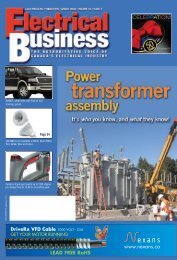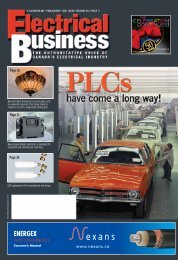Page 27 Page 32 Page 17 - Electrical Business Magazine
Page 27 Page 32 Page 17 - Electrical Business Magazine
Page 27 Page 32 Page 17 - Electrical Business Magazine
- No tags were found...
You also want an ePaper? Increase the reach of your titles
YUMPU automatically turns print PDFs into web optimized ePapers that Google loves.
From the Legal DesklettersKennedy strongly emphasized the fact that the planthad been specifically purpose-built, and that it andthe equipment must be treated as one integratedwhole, the judge disagreed and found that—in itsessence—there were two separate contracts. Onewas just a building and could have been put to anyuse. This was lienable. The other, which was not,was the supply and installation of equipment forcommercial purposes which could have gone anywhere,given the proper specifications of the buildingit was to be put in.Although his mandate did not require him todo so, the trial judge also made a broad statementto the effect that the installation of anyequipment for commercial usage could never belienable because the Construction Lien Act wasexclusively intended to assist those in the “constructionindustry”, even though the act does notexpressly say so.There was considerable concern about the decision,particularly in the electrical and mechanicalsections of the construction industry. Theimplications are obvious—the old “chattels versusfixtures” debates are no longer relevant. The installationof commercial machinery is not lienable,and any contract between owners and contractorsperforming such work must be revised to protectpayment rights and provide quick remedies.On first appeal, a majority decision in DivisionalCourt upheld Justice Killeen’s decision, albeit witha strong dissent by Madame Justice Chapnick. 2The matter then proceeded, with leave, to theCourt of Appeal. That court released its decision,rejecting the appeal, on September <strong>27</strong>.The court’s basic reason for dismissing theappeal was that the trial judge made findings offact supported by at least some of the evidencebefore him, and an appellate court should notinterfere with such findings of fact (except whenthere is clear evidence that the trial judge did notunderstand the evidence or misinterpreted it).On the question of portability of the assemblyline, therefore, Justice Armstrong held that,“While a different judge may have come toanother conclusion on the issue of portability, Iam satisfied that it was open to the trial judge toreach the conclusion that he did”. While it is niceto see the court approving this often-neglectedprincipal of deference to the trial judge—which itdoes not always do—it is always available to themto change the decision if the judge has misappliedlegal principles to those facts.An incorrect statement or application of a legalissue can and should be reviewed by the appellatecourt without deference. I believe this is whatJustice Chapnick was trying to do at the DivisionalCourt level. The Court of Appeal, however, decidedthat the judge was making findings of fact(which could, in theory, be supported by evidencebefore him) and applying the law based on thosefindings. Applying this approach, he had the rightto be wrong as long as his findings were based onsome evidence.Contractors supplying these types of equipmentor materials—and their lawyers—are advised toreview and carefully consider the implications ofthe decision on their own businesses.Notes1. Kennedy Electric Ltd. and Cassidy IndustrialContractors Ltd. v Dana Canada Corp. 2007ONCA 664 (2007) 61 CLR (3d) 1; decision ofOntario Court of Appeal, released Sept. <strong>27</strong> 2007).2. (2006) 50 CLR (3d) 283 (Ont. Div. Ct).Transported to New YorkI enjoyed reading the article about relighting the historic CustomHouse on page 40 in the October 2007 edition. It was so well writtenthat I seemed transported to the site, even though I was never therebefore and have never seen any pictures.Are there any ‘before’ and ‘after’ pictures available, please?— Harald T.Check out www.oldnycustomhouse.gov— Ed.Let’s focus on the good!I was just reading your letter from Brian B. complaining about theHouse of Horrors, and he’s absolutely right (EB Sept 07, “Horrified byhouse of horrors”, page 6). We all slow down to look at car accidents,and this is our version of that same scenario. Perhaps there should bea showcase feature to run alongside the House of Horrors spotlightingcontractors that provide quality workmanship.I am an electrical contractor [that mostly does] custom cottages. Ihave always felt that when terminating the electrical panel it is importantto put a little pride into it and do the best that you can. Whenyou visit a home and end up in the mechanical room, you’re going tonotice the panel—so if the rest of the house looks good, then so shouldthe panel. I was once told that every trade reflects on one another.When a home shows well but the panel is a dog’s breakfast, it bringsdown the quality of the overall project.Also, the panel is about the only place a residential contractor canshow his stuff; everything else is just devices. I’ve never been asked,“Hey, did you install those receptacles? Nice job”. A neat electricalpanel shows pride and craftsmanship. Time-wise I’m pretty sure itworks out about the same [as a sloppy job] when you prepare and thinkabout your approach to the job. Neat workmanship also also generateswork because when someone sees a job well done, and they’re in themarket for an electrical contractor, you will be getting that call.Thanks, and I’ll look forward to next month’s <strong>Electrical</strong> <strong>Business</strong>, asthere are always interesting articles inside.— James P.Introducinga new lineof CAT IVInsulationTesters!Hammond NewsHammond Manufacturing is proud to offer our full-line E5 standardproduct catalog. This 500 page book adds over 1000 new SKU's to ourprevious edition.Sloped Top - <strong>Page</strong> 76RAL7035 Wallmount - <strong>Page</strong> <strong>32</strong>NEW Megger MIT400 SeriesThe high performance testerperfect for commercial andplant electricians CAT IV 600 V Rated Adjustable Insulation Test Voltages –provides 10 V to 1000 V Exceptional measurement rangefrom 20 G to 200 G Pass/Fail Limit Alarm Automatically performs PolarizationIndex tests True RMS voltage measurement Results storage and wireless Bluetooth TMdownload 3 year warrantyWWW.MEGGER.COMNew products added:• Numerous standard size stainless steel enclosures• Sloped top enclosures - mild and stainless steel• Eclipse wallmount enclosures available in RAL7035• Full line of commercial boxes and splitters• OEM friendly polyester enclosure line - PJU Series• Enhanced climate control offering• Much, much moreCommercial Box - <strong>Page</strong> 342OEM Polyester - <strong>Page</strong> 122Contact your Hammond Distributor or visit us online atwww.hammfg.com to get your catalog today.Hammond Manufacturing Co. Ltd394 Edinburgh Road NorthGuelph, Ontario N1H 1E5Offices in Montreal, Edmonton, Toronto1-800-297-9688Info no. 16Tel: (519) 822-2960 or (905) 456-3770Fax: (519) 822-0715sales@hammfg.comwww.hammfg.comInfo no. <strong>17</strong>Megger_EB_May07.indd 15/7/07 11:46:01 AMwww. mag.com • november/december 2007 • 15
















